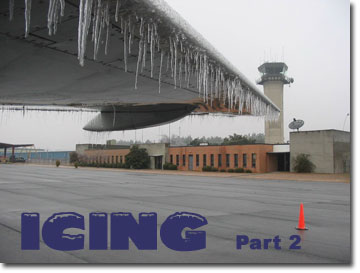 |
|
Carburetor Icing: Part II, Symptoms and Remedies
Last month, we looked into the origins of carburetor icing and other forms of air intake ice formation. We discussed fuel vaporization icing, caused by the process of vaporizing fuel as it passes through the carburetor, throttle icing, caused by reduction of pressure as air passes through the venturi tube and impact icing, caused when temperatures are below 5º C and water, in its various forms, can freeze on contact with intake filters and at bends in the intake system. Today, we’ll have a look at the symptoms of building ice and the remedies available to us. Recognizing the potential for icing problems is a good first step. What is the air temperature outside? Most aircraft are fitted with a thermometer allowing us to monitor outside air temperature. Outside air temperatures between –5º C and +15º C combined with moist conditions are ideal for the formation of carburetor ice. We don’t normally have a direct method for measuring the relative humidity in flight. Before taking off, however, a study of the applicable METARs and TAFs will give us valuable information. As a start, check the spread between temperature and dew point. You may want to discuss the likelihood of carburetor icing conditions with your friendly flight service specialist when you call for your weather briefing. If your aircraft is fitted with a carburetor mixture temperature gauge you will be able to monitor the temperature of the fuel/air mixture. If the mixture is maintained in the temperature range between 4º C and 7º C by using carburetor heat, you may be able to eliminate the necessary conditions for the formation of carburetor ice by keeping temperatures in the carburetor above freezing. Some aircraft are equipped with a carburetor air inlet temperature gauge, which allows a pilot to monitor incoming air immediately prior to its entering the carburetor. Ideally, we will maintain a temperature in the 32º C to 38º C range (90º F to 100º F) by application of appropriate carburetor heat as required. Baring this fancy equipment—none of my aircraft are so equipped—we are left with the old fashioned way: monitoring atmospheric conditions, monitoring the functioning of the engine and following the correct procedures to prevent the onset of carburetor icing. Ideally, we would like to prevent rather than melt ice. If we find ourselves flying in conditions that appear conducive to the development of carburetor ice, we can apply carburetor heat at regular intervals as both a preventative measure against the formation of ice and a method to test whether or not carburetor ice is developing. If a normal drop in RPM or manifold pressure accompanies the application of carburetor heat, we can be reasonably certain that ice is not forming in the carburetor. Of course, as part of our run-up checks and prior to reducing power for approach, carburetor heat should be applied to ensure no ice is present. Many aircraft manufacturers recommend that carburetor heat be applied whenever the engine is being operated below a stated RPM or manifold pressure reading as a preventative. When an engine is running at reduced power it is producing reduced heat and the potential for ice formation is increased. Although low power settings provide a better environment for the formation of carburetor ice, under the right conditions carburetor ice can form even during a full power climb with the engine producing maximum power and thus maximum heat output. The first signs of carburetor icing are normally
a reduction in available power measured by RPM (fixed pitch propeller)
or manifold pressure (constant speed propeller). A drop in RMP or manifold
pressure, unless the throttle is slipping or the kid sitting next to you
is playing with engine controls, is a key indication that carburetor ice
may be developing. Correct and timely use of carburetor heat is both our best defence against carburetor icing and our best cure should icing occur. When we pull or push or slide the carburetor heat control from the “cold” position to the “hot” position we direct unfiltered, heated air into the carburetor rather than cold, filtered air. Unless we have left things entirely too long, application of carburetor heat will increase the temperature inside the carburetor sufficiently to prevent the accumulation of ice and/or melt any ice that has begun to build. It is unfortunately possible to accumulate such a quantity of ice in a carburetor that application of even full carburetor heat and full throttle will not be sufficient to reverse the process. Prevention and early intervention are the best options. We can expect when ice is present in the carburetor that application of carburetor heat will initially appear to make the problem worse. Application of carburetor heat will begin to melt any ice present in the carburetor. The water will be drawn into the cylinders where it will affect combustion momentarily, producing a bit of rough running. This can increase a pilot’s heart rate if he or she is not prepared and tempt him or her to push the carburetor heat control to the off position. Resist this temptation; despite appearances, things are actually improving. It may be recommended by your aircraft manufacturer to increase throttle to full power when carburetor heat is applied, which serves to open the butterfly valve and increase the amount of heated air passing through the carburetor. This action will speed up the process of ice melt and help return things to normal in minimal time. Check your aircraft POH for details. As the ice disappears we can expect RPM or manifold pressure to increase. This is a good sign and indicates the problem is being successfully dealt with. When you are reasonably certain all ice is gone, reduce power to normal and shut off the carburetor heat. You have dealt with the problem but have also been given a “heads-up”. The conditions you are flying in, apparently, are very suitable for ice formation. It will be an excellent plan to check for ice build-up at regular intervals. Should icing become severe or continuous, you may opt to fly with full application of carburetor heat. This will somewhat reduce available power because heated air is less dense than cold air and will require leaning the engine to accommodate the lower air density entering the cylinders. However, an engine running at somewhat reduced power is certainly preferable to one not running at all. Increasing the throttle setting may allow you to achieve the required power for cruise. Impact icing, formed when supercooled water, sleet or snow begins to freeze on air filters or in intake ducting can cause serious problems. Carburetor heat, if you are so equipped may assist as may alternate air for a fuel-injected engine. In both cases, you will need to adjust mixture and possibly increase throttle setting to maintain constant power. Changing altitude or direction of flight may also be strongly indicated if the problem is more than momentary. Other forms of airframe icing may also begin to appear under these conditions giving a strong indication you are in the wrong place and should do something positive about it very soon. Many low time pilots who have flown only in excellent weather may not have experienced carburetor or impact icing and may not quite believe in its reality. It is important to take the phenomenon seriously, to understand the conditions that allow it to develop, to have some knowledge of how it is created in the engine and its effects on available power, and to understand what to do to prevent its occurrence or deal with it successfully should it begin to form.
|



